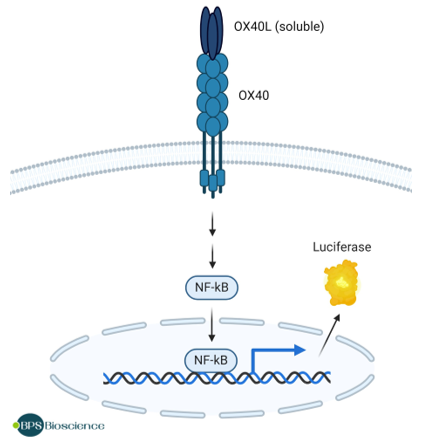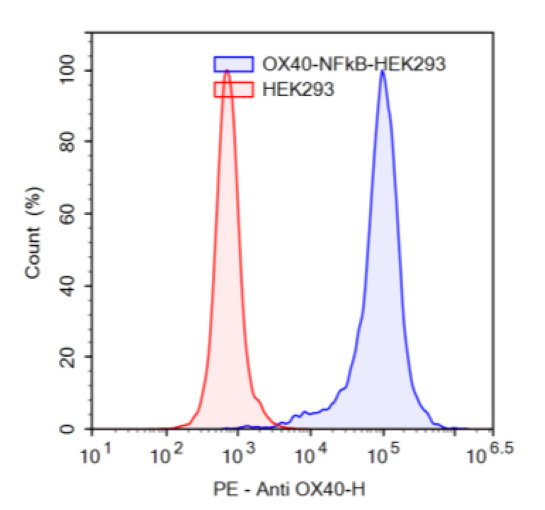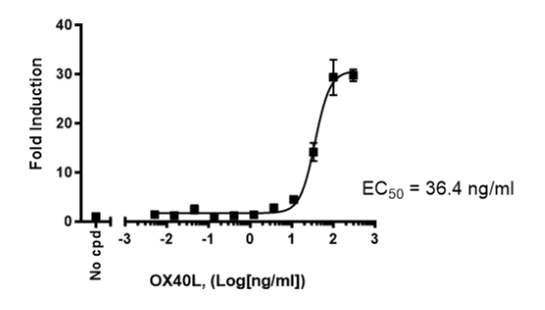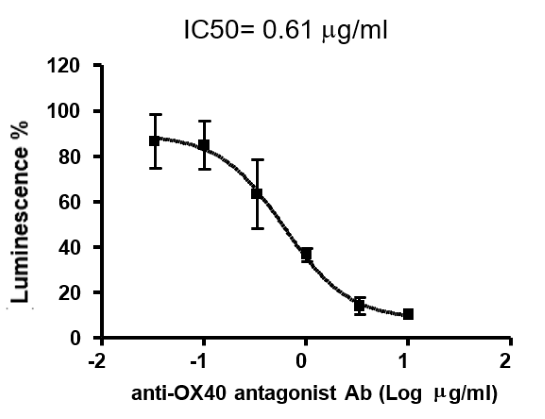OX40/NF-κB Luciferase Reporter HEK293 Cell Line
The OX40/NF-κB Luciferase Reporter HEK293 Cell Line is a HEK293 cell line expressing the Firefly luciferase reporter under the control of NF-κB (nuclear factor kappa light chain enhancer of activated B cells)-responsive elements and OX-40 (Tumor Necrosis Factor Receptor Superfamily Member 4, GenBank Accession No. NM_003327).
This cell line has been validated by flow cytometry, and with OX40L and anti-OX40 antagonist antibodies.

Figure 1: Illustration of mechanism of action of the OX40/NF-κB Luciferase Reporter HEK293 Cell Line.
Interested in screening and profiling inhibitors, blocking antibodies, or activators of OX40 without the need to purchase and license the cell line? Check out our Cell Signaling Pathway Screening.
This product has been cited 2 times.
Purchase of this cell line is for research purposes only; commercial use requires a separate license. View the full terms and conditions.
Media Required for Cell Culture
| Name | Ordering Information |
| Thaw Medium 1 | BPS Bioscience #60187 |
| Growth Medium 1A | BPS Bioscience #79528 |
Materials Used in Cellular Assay
| Name | Ordering Information |
| Assay Medium: Thaw Medium 1 | BPS Bioscience #60187 |
| Growth Medium 1A | BPS Bioscience #79528 |
| OX40L (CD252), His-tag (Human) Recombinant | BPS Bioscience #71185 |
| Anti-OX40 Antagonist Antibody | BPS Bioscience #72063 |
| Clear-bottom, white 96-well tissue culture-treated plate | Corning #3610 |
| ONE-Step™ Luciferase Assay System | BPS Bioscience #60690 |
| Luminometer |
The cell line has been screened to confirm the absence of Mycoplasma species.
OX40, also known as CD134, is a co-stimulatory receptor, of the TNF (tumor necrosis factor) receptor family, expressed on the surface of T cells. Binding of OX40 to its ligand, OX40L (also known as CD252), potentiates T cell activation, differentiation, proliferation, survival, and T cell effector function. OX40L is present in NK cells, participating in their activation and cytotoxicity profile, and dendritic cells. OX40 can bind to members of the TRAF (TNFR associated factor) family of proteins, which can then regulate the NF-κF (nuclear factor kappa-light chain enhancer of activated B cells) signaling pathway. OX40 and OX40L can be found in cancer cells, such as AML (acute myeloid leukemia) and breast cancer cells. Studies have shown that OX40 agonists can increase anti-tumor immunity and improve tumor-free survival in pre-clinical studies. Alternatively, OX40 antagonists offer potential as therapeutics for inflammatory diseases. The development of new modulators of the OX40/OX40L activity are promising therapies for patients suffering from solid tumors or auto-immune disorders.
Peng K., et al., 2014 AAPS J. 16(4): 625–633.
Marconato M., et al., 2022 Scientific Reports 12: 15856.




